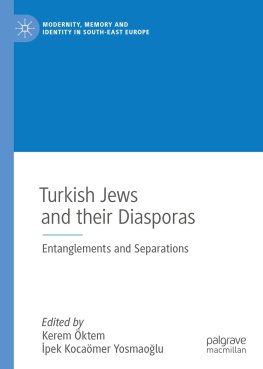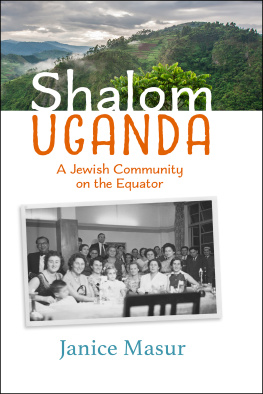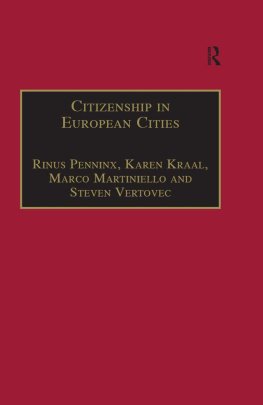Lilach Lev Ari - Contemporary Jewish Communities in Three European Cities
Here you can read online Lilach Lev Ari - Contemporary Jewish Communities in Three European Cities full text of the book (entire story) in english for free. Download pdf and epub, get meaning, cover and reviews about this ebook. year: 2022, publisher: Walter de Gruyter GmbH & Co KG, genre: Politics. Description of the work, (preface) as well as reviews are available. Best literature library LitArk.com created for fans of good reading and offers a wide selection of genres:
Romance novel
Science fiction
Adventure
Detective
Science
History
Home and family
Prose
Art
Politics
Computer
Non-fiction
Religion
Business
Children
Humor
Choose a favorite category and find really read worthwhile books. Enjoy immersion in the world of imagination, feel the emotions of the characters or learn something new for yourself, make an fascinating discovery.

- Book:Contemporary Jewish Communities in Three European Cities
- Author:
- Publisher:Walter de Gruyter GmbH & Co KG
- Genre:
- Year:2022
- Rating:3 / 5
- Favourites:Add to favourites
- Your mark:
- 60
- 1
- 2
- 3
- 4
- 5
Contemporary Jewish Communities in Three European Cities: summary, description and annotation
We offer to read an annotation, description, summary or preface (depends on what the author of the book "Contemporary Jewish Communities in Three European Cities" wrote himself). If you haven't found the necessary information about the book — write in the comments, we will try to find it.
Contemporary Jewish Communities in Three European Cities — read online for free the complete book (whole text) full work
Below is the text of the book, divided by pages. System saving the place of the last page read, allows you to conveniently read the book "Contemporary Jewish Communities in Three European Cities" online for free, without having to search again every time where you left off. Put a bookmark, and you can go to the page where you finished reading at any time.
Font size:
Interval:
Bookmark:


- Preface
- Chapter 1 Introduction: Social Migration, Ethnic Identity, Socio-Cultural Integration and Acculturation of Migrants and Ethnic Minorities
- 1.1 Social Migration: Definition and Theories
- 1.2 Ethnic Identity and Identification
- 1.3 Social Networks and Community
- 1.4 Acculturation and Cultural Integration
- 1.5 World-Wide Jewry: Between Privileged Minorities and Antisemitism
- 1.5.1 Jews as Urban Minorities: Dynamic Patterns of Identity
- 1.5.2 Antisemitism: New and Old
- 1.6 Jews in Contemporary Europe: Between Individual, Collective and National
- 1.6.1 From Colonialism to Resettlement: Policy towards Immigrants and Ethnic Minorities in Europe after World War II
- 1.6.2 Recent Antisemitism in Europe (France and Belgium Included)
- 1.6.3 Jews in Contemporary Europe: Changing Boundaries of Integration and Identity
- 1.7 Structure of the Book
- Chapter 2 The Participants: Socio-Demographic and Socio-Economic Characteristics
- 2.1 Overview
- 2.2 Socio-Demographic Characteristics by City of Residence
- 2.3 Socio-Economic Characteristics by City of Residence
- 2.4 A Comparison between Native-Born and Immigrants according to Background Characteristics
- 2.5 Summary
- Chapter 3 Inter-Relations between Jewish and Non-Jewish Communities in Paris, Brussels and Antwerp: Macro Perceptions
- 3.1 Overview
- 3.2 City and Neighborhoods Changing Ethnic Structure: Where Jews Arrive the Prices Go Up
- 3.3 Inter-relations among Ethnic Groups in City of Residence: It Feels Less Secure Outside
- 3.4 Summary
- Chapter 4 Between Integration within the Non-Jewish Majority and Segregation
- 4.1 Overview
- 4.2 Integration within Non-Jewish Majority Communities: Social, Communal and Cultural
- 4.3 Professional Integration within Host Societies: I Am Grateful to France
- 4.3.1 Paris
- 4.3.2 Brussels and Antwerp
- 4.4 Socio-Cultural Integration with Non-Jews: I Probably Live in a Bubble
- 4.4.1 Paris
- 4.4.2 Brussels
- 4.4.3 Antwerp
- 4.5 Predispositions and Motives for Future Emigration
- 4.6 Summary
- Chapter 5 In Their Eyes: Antisemitism in Every-Day Life
- 5.1 Overview
- 5.2 Perceptions regarding Antisemitism: The Jews, They Are Not Part of the Celebration
- 5.2.1 Paris
- 5.2.2 Brussels
- 5.2.3 Antwerp
- 5.3 Antisemitism and Future Emigration
- 5.4 Summary
- Chapter 6 Changes in Jewish Communal Organizations Structure, Involvement and Social Networks
- 6.1 Overview
- 6.2 Dynamic Macro Structure and Vitality of the Three Jewish Communities
- 6.2.1 Paris
- 6.2.2 Brussels
- 6.2.3 Antwerp
- 6.3 From Personal Perspectives: Communal Integration and Social Networks: I Have a Feeling That We Are Both Flying to the Same Destination, but to Two Different Destinations
- 6.3.1 Integration within Jewish Local Communities: Social, Communal, Educational and Cultural
- 6.3.2 Social Networks
- 6.4 Summary
- Chapter 7 Ethnic Identity and Identification: Challenges, Continuity and Revival
- 7.1 Overview
- 7.1.1 Cultural integration, ethnic identity and identification in France
- 7.1.2 Cultural integration, ethnic identity and identification in Belgium
- 7.2 Jewish Background: A Comparison by Cities of Residence and Groups (Native-Born and Immigrants)
- 7.3 Jewish Ethnic Identity
- 7.3.1 Transnational Identity and Attachment to Israel: I Am Totally at Home in the Two Countries
- 7.3.2 Multiple Ethnic Identities
- 7.3.3 Identity Conflicts: It Turns Out That It Is Not So Easy to Escape from Identity
- 7.4 Jewish Ethnic Identification
- 7.4.1 Jewish Practice
- 7.4.2 Language Usage
- 7.4.3 Childrens Jewish Socialization and Education
- 7.5 Summary
- 7.1 Overview
- Chapter 8 Discussion: Two Jewish Communities in Three Cities - Challenges of Integration, Acculturation and Identity
- 8.1 Overview
- 8.2 Integration and Acculturation to the Non-Jewish Majority
- 8.3 Jewish Communal Continuity and Vitality
- 8.4 Cultural Integration within Jewish Communities: Ethnic Identity and Acculturation
- 8.5 Policy Trajectories and Further Research
- References
- Index
Font size:
Interval:
Bookmark:
Similar books «Contemporary Jewish Communities in Three European Cities»
Look at similar books to Contemporary Jewish Communities in Three European Cities. We have selected literature similar in name and meaning in the hope of providing readers with more options to find new, interesting, not yet read works.
Discussion, reviews of the book Contemporary Jewish Communities in Three European Cities and just readers' own opinions. Leave your comments, write what you think about the work, its meaning or the main characters. Specify what exactly you liked and what you didn't like, and why you think so.





